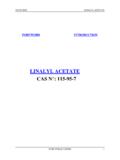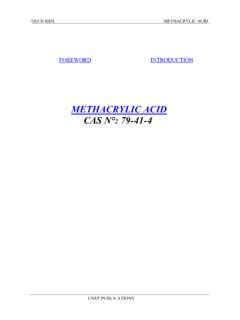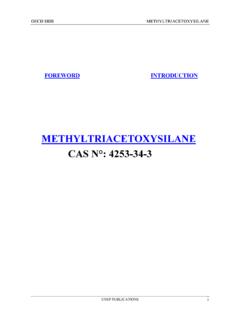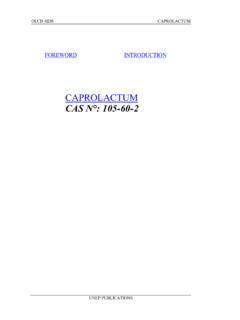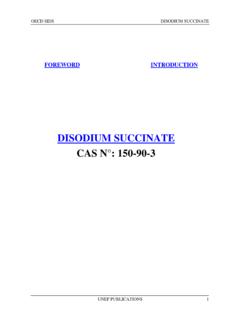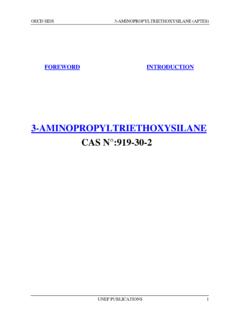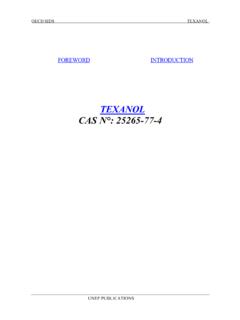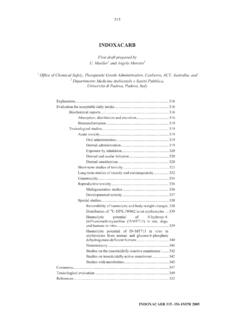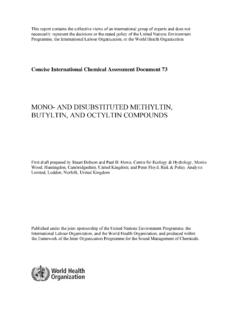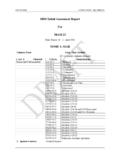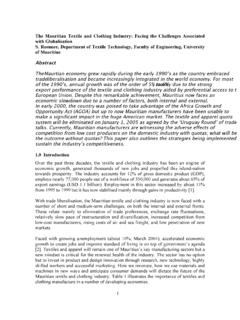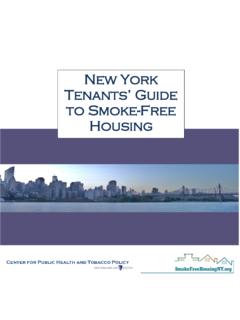Transcription of n-Butyl Alcohol CAS N°: 71-36-3 - inchem.org
1 OECD sids n-Butyl Alcohol . FOREWORD INTRODUCTION. n-Butyl Alcohol CAS N : 71-36-3 . UNEP PUBLICATIONS 1. OECD sids n-Butyl Alcohol . sids Initial Assessment Report For SIAM 13. Bern, Switzerland, 6 - 9 November, 2001. 1. Chemical Name: n-Butyl Alcohol 2. CAS Number: 71-36-3 . 3. Sponsor Country: United States of America National sids Contact Point in Sponsor Country: Oscar Hernandez, Division Director RAD. 7403 M. 1200 Pennsylvania Avenue Washington DC, 20460. (202) 564-7461. 4. Shared Partnership with: American Chemistry Council Doug Anderson, Oxo Process Panel 1300 Wilson Blvd. Arlington, VA 22209. (703) 741-5616. 5. Roles/Responsibilities of the Partners: x Name of industry sponsor /consortium x Process used 6. Sponsorship History The work and review process undertaken for this chemical was done by the American Chemistry Council's Oxo Process Panel and the United States Environmental Protection Agency.
2 Members of the Oxo Process Panel conducted a comprehensive literature search. Documents were prepared and reviewed by industry prior to submission to sponsor country. Sponsor country conducted reviews of submitted data and offered comments to industry. Industry prepared and resubmitted documents for consideration at SIAM 13. x How was the chemical or category brought into the OECD HPV Chemicals 2 UNEP PUBLICATIONS. OECD sids n-Butyl Alcohol . Programme ? 7. Review Process Prior to the SIAM: 8. Quality check process: 9. Date of Submission: September 14, 2001. 10. Date of last Update: June 2004. 11. Comments: Testing: No testing (X). Testing ( ). UNEP PUBLICATIONS 3. OECD sids n-Butyl Alcohol . sids INITIAL ASSESSMENT PROFILE. CAS No. 71-36-3 . Chemical Name n-Butyl Alcohol Structural Formula CH3-CH2-CH2-CH2OH. RECOMMENDATIONS. The chemical is currently of low priority for further work. SUMMARY CONCLUSIONS OF THE SIAR.
3 Data from butyl acetate (BAc) toxicity studies have been included in the assessment of n-butanol (BA). Data from BAc is useful when assessing the hazards associated with the systemic toxicity of BA exposure due to the rapid and complete hydrolysis of BAc to BA in vivo. Exposure to BAc via dermal, inhalation, and water or dietary administration results in the rapid appearance of BA in the systemic circulation. Since exposure to either BAc or BA results in systemic exposure to BA, systemic toxicity data from studies that administer BAc are useful in identifying hazards associated with BA exposure. Endpoints of BAc toxicity that are associated with direct contact- mediated effects ( eye, skin, and respiratory tract irritation) cannot be extrapolated from BA data due to the difference in physical-chemical properties of the two materials. Human Health n-Butyl Alcohol (BA) was only slightly toxic to experimental animals following acute oral, dermal, or inhalation exposure.
4 The acute oral LD50 values for female rats ranged from 790 to 4360 mg/kg. Different strains of rat were used in each of four studies, which may account for the variability. Oral LD50 values for mice, rabbits, hamsters, dogs, and male rats all fell within the same range. The rat inhalation LC0 of 8000 ppm (24000 mg/m3) indicates very low inhalation toxicity (no lethality at 8000 ppm). The rabbit dermal LD50 was 3402 mg/kg, indicating that BA. can penetrate the skin, but not very readily. Animal experiments and human experience indicate that BA is, at most, moderately irritating to the skin, but it is a severe eye irritant. These effects are most likely due to BA's localized defatting and drying characteristics. Although no animal data are available, human studies and experience show that BA is not likely to be a skin sensitizer. A recent in vivo toxicokinetics study confirmed the rapid metabolism of n-Butyl acetate (BAc) to BA.
5 Hydrolysis of BAc in blood and brain was estimated to be 99 percent complete within minutes (elimination t = minute). Thus, organisms exposed to BAc can experience appreciable tissue concentrations of BA. In this way, the results of toxicity studies with BAc can be used as supplemental, surrogate data to provide information on the toxicity of BA. A thirteen-week, subchronic exposure to BAc, the metabolic precursor of BA, produced transient hypoactivity (during exposure only) at 1500 and 3000 ppm (7185 and 14370. mg/m3) along with decreased body weight and food consumption, but no post exposure neurotoxicity even at 3000. ppm. A concurrent subchronic neurotoxicity study under the same exposure conditions showed no evidence of cumulative neurotoxicity based upon functional observational battery endpoints, quantitative motor activity, neuropathology and scheduled-controlled operant behavior endpoints.
6 A no observable effect level (NOAEL) of 500 ppm (2395 mg/m3) was reported for systemic effects in rats, and a NOAEL of 3000 ppm (14370 mg/m3) was reported for post exposure neurotoxicity in rats. Several studies indicate that BA is not a reproductive toxicant. Female rats exposed to 6000 ppm (18000 mg/m3) BA throughout gestation and male rats exposed to 6000 ppm (18000 mg/m3) BA for six weeks prior to mating showed no effects on fertility or pregnancy rate. Male rats given BA at 533 mg/kg/day for 5 days had no testicular toxicity. BA produced only mild fetotoxicity and developmental alterations at or near the maternally toxic (even lethal) dose of 8000 ppm (24000 mg/m3) throughout gestation. An entire battery of negative in vitro tests and a negative in vivo micronucleus test indicate that BA is not genotoxic. The median odor threshold for BA ( ppm) is well below the lowest nasal irritation threshold in humans (289.)
7 Ppm), allowing warning of possible chemical exposure prior to nasal irritation occurring. Human studies are complicated by the odor characteristics of the material, as the odor threshold is well below the levels at which 4 UNEP PUBLICATIONS. OECD sids n-Butyl Alcohol . irritation is observed. Environment BA's vapor pressure is kPa at 200C, water solubility is 77 g/L at 200C and a Log Kow is Based on level III. fugacity modeling, BA will partition in air, in soil, in water, < in suspended solids, and < in biota and in sediment. BA degrades in air by reaction with hydroxyl radicals, having a half-life in air of to days. The volatilization half-life for BA in water is estimated to be hours for streams, hours for rivers and 126 days for lakes. BA exhibits low toxicity to fish, amphibians and aquatic invertebrates, plants, algae, bacteria and protozoans. However, some algal species are sensitive to BA.
8 Acute toxicity to aquatic life may occur at concentrations greater than 500 mg/l. BA is classified as readily biodegradable under aerobic conditions. The octanol:water partitioning coefficient (log Kow) for BA ranges from to , and the calculated bioconcentration factor (BCF) is 3. These data indicate that BA has a low potential to bioaccumulate. BA is expected to migrate readily through soil to groundwater and not to sorb to soil particles. Exposure BA is used primarily as an industrial intermediate in the production of ethers and butyl ether acetates, pharmaceuticals, polymers and plastics. BA is used to a lesser extent as a solvent, reactant/diluent and component in consumer (nail polish formulations, rubber cement and safety glass) and industrial products. Production in the US is estimated at 784,000 tonnes, 575,000 tonnes in Western Europe and 225,000 tonnes in Japan. In regards to physical hazards of the chemical, it has a flammable range of volume % in air (14,000 112,000 ppm).
9 And a flash point of 980F (370C). In the US, due to the physical chemical properties of BA, workplace exposure during manufacture and use as industrial intermediate is limited by closed processing. For the same reasons, exposure is not anticipated during the formulation of butyl Alcohol into various products as a solvent. Inhalation and dermal exposure can occur during industrial and commercial application of products containing butyl Alcohol , such as lacquers and other coatings. Use in consumer products is limited, but is a possible source of exposure. Releases to the environment are primarily from solvent use. Butyl Alcohol occurs naturally in foods. NATURE OF FURTHER WORK RECOMMENDED. No recommendation. UNEP PUBLICATIONS 5. OECD sids n-Butyl Alcohol . sids Initial Assessment Report 1 IDENTITY. Identification of the Substance CAS Number: 71-36-3 . Chemical Name: n-Butyl Alcohol Molecular Formula: CH3-CH2-CH2-CH2OH.
10 Structural Formula: CH3-CH2-CH2-CH2OH. Molecular Weight: g/mol Synonyms: 1-butanol, butan-1-ol n-Butyl Alcohol butyl Alcohol butyl hydroxide butyric Alcohol 1-hydroxy butane hydroxybutane methylolpropane NBA. normal primary butyl Alcohol BA. propylcarbinol propyl methanol Purity/Impurities/Additives Purity Impurities Isobutanol Physico-Chemical properties Table 1 Summary of physico-chemical properties Property Value Physical Form of Marketed Product Neat Liquid Melting point C. Boiling point C. Relative density g/cm3. Vapour pressure kPa at 20 C. Water solubility 77 g/l at 20 C. Partition coefficient n-octanol/water (log value) Odor Threshold 15 ppm (average). Conversion Factor 1ppm = mg/ m3 at 25 C. Flashpoint 98 F (37 C). 6 UNEP PUBLICATIONS. OECD sids n-Butyl Alcohol . n-Butyl Alcohol (BA) is a liquid at standard temperature and pressure, with a boiling point of approximately C and a melting point of approximately C (Union Carbide Corporation, 1992a).
